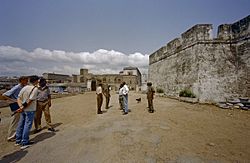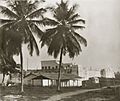Fort William, Ghana facts for kids
Quick facts for kids Fort William |
|
|---|---|
| Part of British Gold Coast | |

Fort William
|
|
| Coordinates | 5°10′27″N 1°07′08″W / 5.17419°N 1.1189°W |
| Site history | |
| Built | 1753 |
| Garrison information | |
| Occupants | Britain (1753–1957) |
Fort William is a historic fort located in Anomabu, a town in the Central Region of Ghana. It was first known as Fort Anomabo. Later, in the 1800s, its commander, Brodie Cruickshank, renamed it Fort William. He also added another floor to the main building.
The British built this fort in 1753. They did this after stopping the French from building their own fort in the same spot. Before Fort William, two other forts stood here. The Dutch built one in 1640. The English built another, called Fort Charles, in 1674. Fort Charles was later left empty in 1730 and then destroyed.
Fort William is one of many important castles and forts in Ghana. In 1979, UNESCO added it to its World Heritage List. This is because the fort played a big role in the Atlantic slave trade. It stands as a reminder of that time in history.
Contents
Fort William's History
Early Forts in Anomabu
The story of Fort William starts long before 1753. In 1640, the Dutch built the very first simple fort here. It was a stone and brick building.
Over the years, different European powers took control of this spot:
- In 1653, the Swedes captured the Dutch building.
- In 1657, Danish forces took it over.
- Around 1659 or 1660, the Dutch got it back.
After a war between the English and the Dutch, the English gained a strong presence in Anomabu. In 1672 or 1673, the English started building their own fort. They named it Fort Charles, after King Charles II of England. This was on the same land where Fort William stands today. An early local chief might have lived in the old Dutch building at this time.
The English later left Fort Charles. They wanted to focus their money and efforts on a bigger fort. This was Fort Carolusburg in Cape Coast.
A Busy Trading Post
In the late 1600s, the Royal African Company was a British company that controlled trade in this area. They started allowing other ship captains to trade if they paid a fee. Many of these "Ten Percenters" came to British forts like Anomabu. They often had more ships than the company itself.
Anomabu became a very popular place for trading. A Dutch leader in 1717 shared some numbers. He said that from 1702 to 1708, over 30,000 enslaved people were taken from Anomabu to places like Barbados and Jamaica. This shows how active the trade was at Anomabu.
Building Fort William
In 1753, the British built Fort William. This happened after they stopped the French from building a fort in Anomabu. The British African Company of Merchants built it. This company took over from the Royal African Company.
A military engineer named John Apperly designed the fort. He also became its first governor. After Apperly passed away in 1756, an Irishman named Richard Brew took charge. He finished building the fort in 1760.
Fort William became a main center for the British in the Gold Coast for trading enslaved people. This continued until the trade was made illegal in 1807.
Today, Anomabu is a popular place for visitors. You can still see the well-preserved parts of Fort William.
Gallery
People Connected to Fort William
- Venture Smith
- William Ansah Sessarakoo









